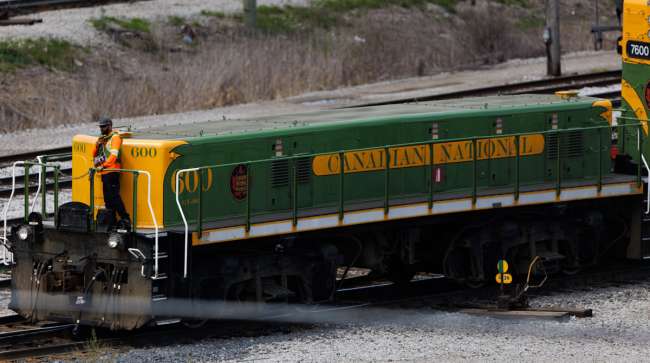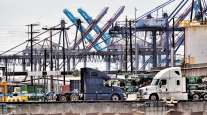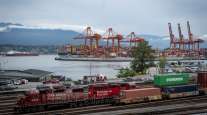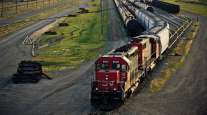Staff Reporter
Canadian Rail Operations Back on Track After Work Stoppage

[Stay on top of transportation news: Get TTNews in your inbox.]
Canadian railway operations have resumed after a brief work stoppage, following government intervention in an ongoing labor dispute.
The Canada Industrial Relations Board ordered an end to the shutdown Aug. 24, forcing Canadian National Railway Co., Canadian Pacific Kansas City and the Teamsters Canada Rail Conference back to the negotiating table.
“CIRB has also ordered that no further labor stoppage, including a lockout or strike, can occur during the arbitration process,” Canadian National said in a statement Aug. 24. “This means that the strike notice recently issued to CN by the Teamsters is now voided. CN will comply with the order which also extends the current collective agreement until a new agreement is signed.”
The labor dispute, which has been ongoing for nearly a year, escalated when the railway companies locked out workers Aug. 22 in anticipation of a potential strike. The CIRB ruling required the companies to resume operations and unionized workers to return to their duties.
Want more news? Listen to today's daily briefing above or go here for more info
TCRC opposed the decision, having long resisted attempts by the companies to enter binding arbitration.
“This decision by the CIRB sets a dangerous precedent,” TCRC President Paul Boucher said Aug. 24. “It signals to corporate Canada that large companies need only stop their operations for a few hours, inflict short-term economic pain, and the federal government will step in to break a union. The rights of Canadian workers have been significantly diminished today.”
CIRB had ruled Aug. 9 that railway workers could strike without risking public health or safety but included a 13-day cooling-off period. This led the companies to lock out workers and shut down operations Aug. 22 in preparation for an expected strike.
RELATED: US Shippers Scramble as Canadian Rail Shutdown Hits Freight
“Our team is executing its restart plan for the safe and orderly resumption of rail service across Canada,” CPKC said in a statement Aug. 24. “We are working with customers on a balanced return to normal operations.” The CIRB planned to convene a case management meeting with the parties Aug. 29 to discuss final binding arbitration.
While TCRC and the railway companies have expressed their intent to comply fully with the binding arbitration order, the union is planning to appeal the ruling in federal court. Some union members also protested outside a Liberal Party of Canada Laurier Club fundraiser in Halifax, Nova Scotia.
Transtex CEO Mathieu Boivin discusses the environmental sustainability of auxiliary power units. Tune in above or by going to RoadSigns.ttnews.com.
“From our experience with previous rail strikes in Canada, we expect it to take up to a week for each railroad to be fully reset and running smoothly again,” said Scott Shannon, vice president for Canada at C.H. Robinson Worldwide. “It will take much longer to catch up with shipments that have gotten backlogged. Railroads are like an outdoor conveyor belt that never quits running.”
Shannon added that railroads aren’t designed to stop and start, as they’re meant to operate continuously. He noted these work stoppages can cause problems with equipment and personnel that need to be repositioned and restarted across the rail network. It can also cause bottlenecks where railways intersect with other sectors like ports.

Shannon
“For our customers whose cargo we’ve been diverting to U.S. ports so they can use U.S. railroads, we advise they return to Canadian gateways as soon as it’s practical,” Shannon said. “This is part of our contingency planning for what could be the first strike in 44 years at U.S. ports along the East Coast and Gulf Coast, possibly at the end of September.”
Shannon is hopeful this action will soon ease the container shortage that developed in Canada as a result of rail strike preparations. He noted shipments being diverted to U.S. ports meant fewer import containers were coming into Canada. C.H. Robinson also switched from rail to trucks to keep customer supply chains flowing.
C.H. Robinson ranks No. 2 on the Transport Topics Top 100 list of the largest logistics companies in North America.

Sidenberg
“The markets most affected by the strike include longhaul intra-Canada (East-West), tri-axle and quad-axle, and dangerous goods,” said Noah Sidenberg, general manager of Canadian sales and operations at Arrive Logistics, which ranks No. 36 on the TT logistics 100. “As all that rail volume converted to over-the-road, it flooded the market and exceeded supply. This situation was magnified with heavy-haul loads, as shippers attempted to mitigate the number of trucks needed for their rail freight.”
Sidenberg highlighted several notable trends resulting from the disruption, including that the longhaul intra-Canada market saw the greatest increase in volume. Dangerous cargo was especially affected by embargoes to prevent hazardous loads from becoming stranded.
“Supply chain operations are returning to normal,” said Jenna Slagle, senior data analyst at Project44. “Despite the increased rail yard dwell times and extended wait times, operations recovered rapidly after the first day of the strike. Average rail transit times increased by 28% due to the strike but have since returned to normal levels.” Slagle noted that Project44 data was not showing lasting impacts on other modes or on-time performance.





